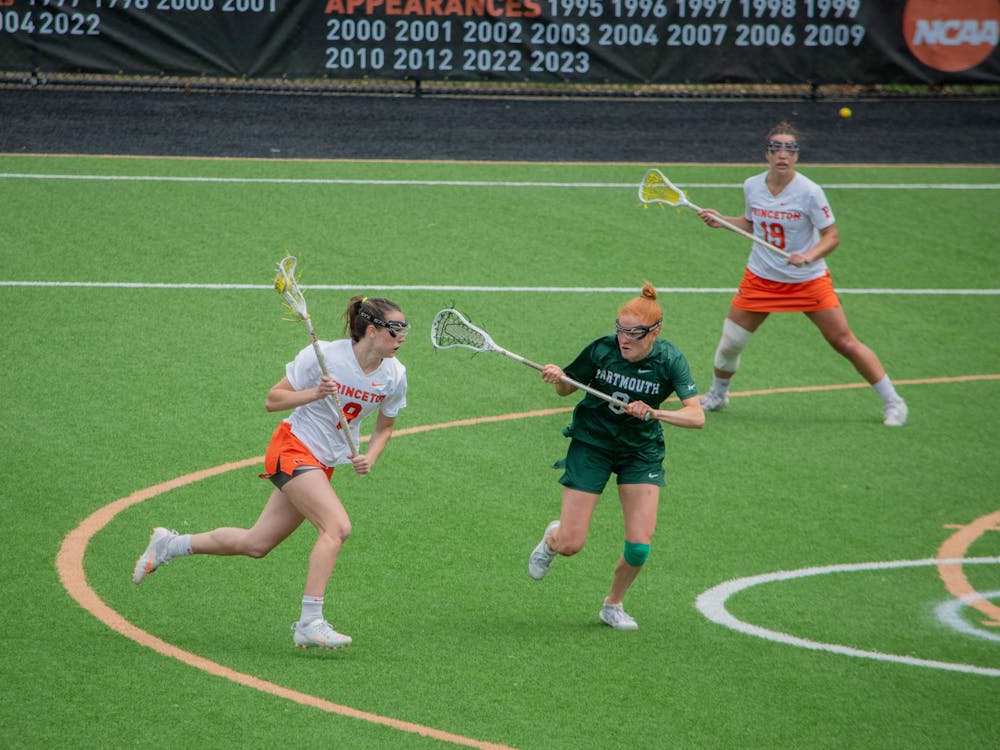Senior track and field athlete Michael Williams is a national class runner. As a key leg of Princeton’s distance medley relay, Williams has won both the prestigious Penn Relays and National Championships. His personal best time of three minutes, 44.97 seconds in the 1500m is tied for number 10 all-time at Princeton. Nevertheless, at the cross country Ivy League Championships this fall, Williams did something he vows never to do again. He gave up.
“Sometimes in longer races, mentally, I lose focus. I’m not tired, but I can’t go any faster,” Williams said. “I know I can run faster, but once you fall apart mentally it’s so hard to put it back together.”
Williams’ momentary mental defeat is not unusual or even surprising.It is a challenge so ubiquitously faced by not just runners, but most competitive athletes, that it happens to almost everyone at some point.
In 2009, Jenny Barringer, a track star from Colorado, entered the NCAA Cross Country Championship meet as the overwhelming favorite. That summer she had placed fifth in the steeplechase at the World Championships, setting an American record in the process. Halfway through the NCAA race and in the lead, burdened with nerves, pressure and expectations, she had a mental breakdown and collapsed to the grass. She got up to finish 163rd.
While much attention is paid toward running more miles, improving form or lifting weights, it is the psychological aspect that can make the difference between a great performance and a disaster.
“Mental toughness is difficult. There’s no specific day that I’ll say to my athletes, ‘Today we work on mental toughness,’ ” women’s track and field and cross country head coach Peter Farrell said. “It’s an everyday type of thing.”
What mental strength actually entails is vague. For some it is being able to stay calm under stress, or it is about how far they can push themselves to the edge in order to win. Others see it as being able to “want it” even when the reasons are not concrete.
“How far someone is willing to go is dependent on how badly they want it, be it racing, school, work or whatever,” junior Sam Pons said. “This is what makes running fundamentally difficult … Everyone can run fast when there is a tiger chasing them because their life is on the line, but how many can do the same when the tables are reversed and the only thing to chase is the clock?”
For the Tigers, the mental struggle can begin well before they even toe the line. It starts with the countless workouts run in between races, getting out of bed on early mornings, putting down foot after foot through weeks when they can log between 90 and 100 miles.
“There are days when there’s bad weather, you’re bored, you’re tired, or you’re just unmotivated,” senior cross country co-captain Alejandro Arroyo Yamin said. “What really keeps me going is the thought that everyone is doing it — other runners, my rivals, my teammates. I have to do it for the team; I have to do it for myself. Get up and go.”
At other times during the season, however, psychological strength might lie in being able to hold back.
“The hardest part is making yourself be reasonable. It’s too easy to be carried away and be too ‘tough’ — to do too much, too hard, too soon,” junior cross country co-captain Emily De La Bruyere said. “You have to be able to take a step back, to relax and take a deep breath, and do that without losing your competitive edge.”

While training takes deep resolve and meticulous dedication to take care of the little things, the butterflies and breakdowns appear most often at race time.In the pressure-cooker environment of meets, some athletes rise to the occasion, while others wither.
“I’m fond of saying this, ‘I don’t know a thing until I fire a gun,’ ” Farrell said. “Who’s competitive, who’s not competitive. Everyone can go home over the summer and put in the training. But there are some people who are able to race above themselves, who are able to exceed expectations.”
For many athletes like De La Bruyere, dealing with pre-race anxiety is a major issue.
“I try to do everything I can to avoid being nervous. My freshman year I thought the best way to deal with it was to get into this image of ‘The Zone,’ ” De La Bruyere said. “What happened was that I ran races in my head hundreds of time before I even got to the line and was mentally exhausted before it even started.”
Establishing the proper psychological balance is a fine art. It involves having just the right amount of focus, edginess and excitement.
“Finding the right mental state for racing is sometimes difficult,” senior track captain Molly Higgins said. “You can’t go out there thinking that it’s do or die on this one race. You want to be amped up, but you can’t be over-stimulated and have that take away your calm.”
Once the actual running begins, nerves are forgotten, replaced by the real hurt of racing. American track legend Steve Prefontaine is famous for saying, “A lot of people run a race to see who is fastest. I run to see who has the most guts.” Faced with races that can last over 25 minutes of riding the red line, the Princeton distance runners have to be mentally prepared to deal with pain.
For Arroyo Yamin, visualization works best.
“I think of a really happy moment of joy, like how Harry Potter conjures a Patronus. I’ve been doing it since before J.K. Rowling,” Arroyo Yamin said. “I know it’s going to hurt, but the feeling of finishing well and pushing through outweighs it all.”
When internal motivation fails, others like Higgins look to external sources.
“When it gets tough, and things are looking bad, I turn it over to thinking not about racing for myself, but racing for Princeton,” Higgins said. “You’re out there to make a difference for the team. It gives you an excuse to keep running.”
Yet for many more, such as De La Bruyere, there is no specific way out.
“I’m still looking for the answer. I’ve tried saying a mantra; it doesn’t work. When I’m hurting badly enough, saying ‘strength’ isn’t going to help me. Visualizing not hurting isn’t going to make me feel better either,” De La Bruyere said. “Most often I go blank. If I can’t get myself to feel better, at least I can block out what I am feeling.”
While the mental game is a constant, ongoing battle for the Princeton athletes, many of them have come to accept and enjoy the lifestyle.
“At first I didn’t like running just for the sake of running — it was about proving myself,” Arroyo Yamin said. “Over time I’ve come to love going through the motions: training, running with the guys, exploring new places, pushing myself. As long as my knees are OK with it, I will always continue to be running for pleasure.”
For others, there is no getting around the hard facts of the strains imposed by the rigors of high-intensity training. Not all have embraced the process of running for the sake of running, like Arroyo Yamin. It is the thrill of the competition — rising above the nerves, the pain, the doubts, and the inevitable failures — that keeps them in the hunt.
“Running is hard, getting out there and doing it all the time. The training part sometimes kills me,” Williams said. “But one of my favorite feelings is racing, that’s what gets me going. Getting out there and running as fast as I can, that’s why I love it.“









